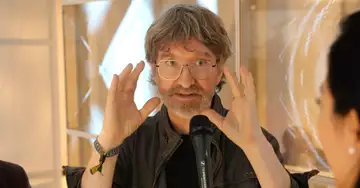After seeing Satoshi Nakamoto turn Bitcoin into a unique digital currency in 2014, Brooklyn-based artist Kevin McCoy obsessively sought a way to do the same with artwork.
This piece is part of CoinDesk's Metaverse week
As a digital artist, McCoy felt marginalized by galleries and museums, in part because of the difficulty of physically exhibiting works that are native to a virtual space.
"The strategy that a lot of digital artists were following at the time, myself included, was to make something physical out of their digital work," he says. "You'd turn it into a sculpture, make some kind of print, develop a robot or whatever. You make something out of it in hopes of participating in the art market."
Eight years later, McCoy recalls that story as he stands in front of nine translucent LG OLED screens displaying his NFT art, "Quantum Leap: Dark Star," which he created in collaboration with his wife, Jennifer McCoy.
"Quantum Leap" is a generative, code-based NFT series of eight tokens that represent the life cycle of stars, changing their shapes and colors over a three-year period. The series was inspired by his 2014 work "Quantum," the first artwork to be tokenized on a blockchain.
"No one really understood the idea of a tokenized digital artwork at the time [and] using the blockchain as proof of ownership and provenance," McCoy said. "It was a real struggle."
Sotheby's touted "Quantum" as "universally considered the first NFT ever created" and auctioned it last June for $1.47 million. The McCoys made it the focus of their presentation at the Frieze Art Fair in New York.
"NFTs invented this new form of digital property, and this idea is just too important to ever go away," he said.
NFTs as an entry point into the metaverseAfterMcCoy
has seenhis original vision of tokenized ownership of art morph into today's non-fungible tokens, he sees NFTs as an entry point into a new way of life
."As the world becomes more digitized and virtualized, the role of digital unique property will increase exponentially. So we're going to live in that world," he said.
McCoy envisions a world five to 10 years from now where the interaction of software with tokens will be more robust and dynamic than ever before.
"The metaverse will be driven by game engines," he said. "And connecting your wallet and tokens to a game engine environment will be the enabling technology."
McCoy compares this point in the metaverse's evolution to the gaming revolution.
"The metaverse of today will be the original Nintendo 10 years from now," McCoy said, describing the turning point when Nintendo released Mario Bros. in 1985. The game about two plumbers navigating the labyrinthine underground pipes of New York City eventually spawned Super Mario Bros, a feature-length movie and animated series.
"The original Mario Bros. is something of a cultural touchstone for people," he said. "
More from Metaverse Week:href="https://www.coindesk.com/layer2/metaverseweek/2022/05/25/not-about-playing-it-safe-krista-kim-on-how-artists-inspire-the-metaverse/">'Not About Playing It Safe': Krista Kim on how artists inspire the MetaverseContemporary artist Krista Kim says there are too many corporate executives conceptualizing these new virtual worlds, and not enough real creatives
. The Metaverse will turn us all into gamers Essentially,the "Metaverse" is a game - but one with real-world consequences and possibilities
. What can you do in the metaverse in 2022? Thefuturepossibilities of the metaverse are probably limitless, but is there anything you can do in the metaverse right now?
Contemporary artist Krista Kim says there are too many corporate executives conceptualizing these new virtual worlds, and not enough real creatives
. The Metaverse will turn us all into gamers Essentially,the "Metaverse" is a game - but one with real-world consequences and possibilities
. What can you do in the metaverse in 2022? Thefuturepossibilities of the metaverse are probably limitless, but is there anything you can do in the metaverse right now?

